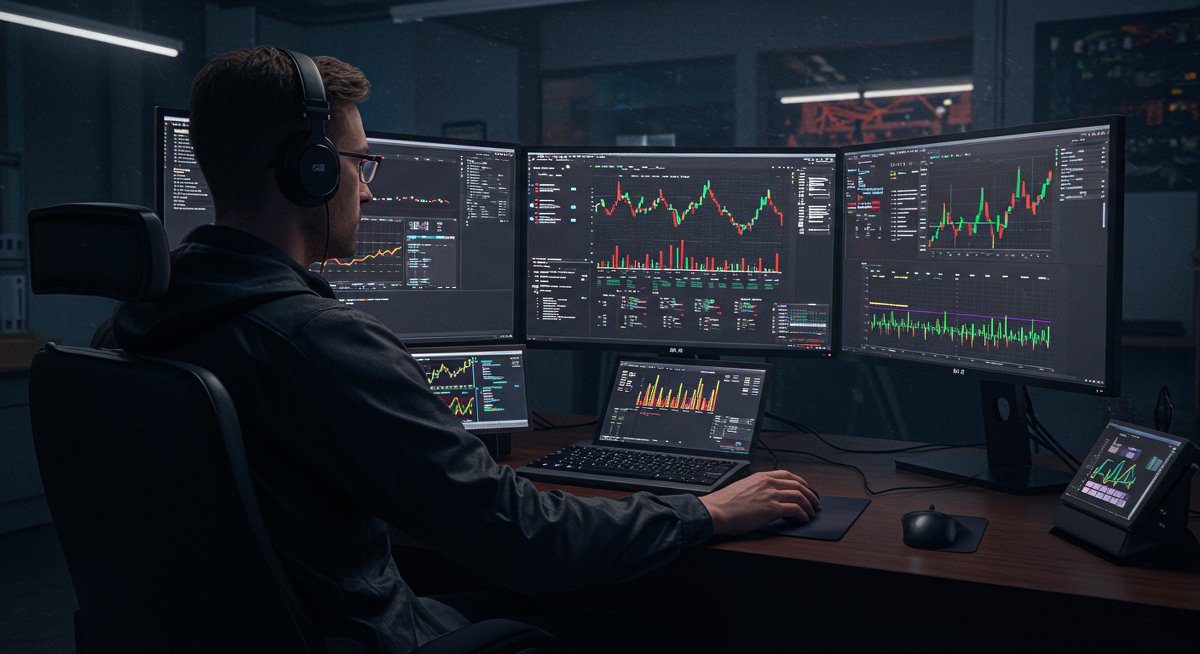So, Bitcoin's Got Everyone Sweating... Again
I came across a post in r/CryptoMarkets that pretty much sums up the current mood: "BTC slips under $116K, ETH holds stronger, are we consolidating or cracking?" Hit the nail on the head, right? Bitcoin's been acting a bit… squirrelly. We saw that dip below $116K (yikes!), Ethereum's trying to play it cool, and altcoins are mostly bleeding. Add in some whale activity and a whole lot of confused retail investors, and you've got a recipe for anxiety. But instead of panicking, let's try to make sense of what's happening and, more importantly, what you should actually do about it – especially if you're trading from outside the US, where things get even more interesting.
This isn't just about charts and graphs; it's about understanding the underlying forces at play. Are we looking at a healthy correction before another leg up, or is this the start of something nastier? Honestly, nobody knows for sure. But by looking at the data, the market sentiment, and the global economic factors, we can at least make some educated guesses and prepare ourselves for different scenarios. And that's what this article is all about.

Decoding the Dip: Whale Moves and Retail FUD
Okay, so Bitcoin dipped. Big deal, right? It's happened before. But this time, it feels a little different. The Reddit post mentioned whales moving, and that's definitely something to pay attention to. When large holders start shifting their Bitcoin, it can trigger a cascade effect, especially if it spooks the retail investors. And let's be honest, the crypto market runs on sentiment as much as it does on fundamentals. Fear, Uncertainty, and Doubt (FUD) can spread like wildfire, leading to panic selling and further price drops.
But here's the thing: whale movements don't always mean a crash is coming. Sometimes, it's just whales rebalancing their portfolios or taking profits. The key is to look at where they're moving their Bitcoin. Are they sending it to exchanges, which could indicate a sell-off? Or are they moving it to cold storage, which suggests they're holding for the long term? Tools like Glassnode and CryptoQuant can help you track these on-chain movements and get a better sense of what the big players are up to. Another factor to consider is the overall macroeconomic environment. Are interest rates rising? Is inflation still a concern? Are there any geopolitical tensions that could be affecting the market? These global factors can all influence Bitcoin's price, regardless of what the whales are doing.
So What Does This Mean For Your Portfolio? Time to Panic? (Spoiler: Probably Not)
Alright, so you've seen the red candles, you've heard the whispers of doom, and you're wondering if you should sell everything and run for the hills. Before you do anything rash, let's take a step back and think about your investment strategy. What are your goals? What's your risk tolerance? If you're a long-term holder, a short-term dip shouldn't be a major concern. In fact, it could even be a buying opportunity. But if you're a short-term trader, you need to be more nimble and prepared to cut your losses if things go south.
Here's what I would consider right now. First, re-evaluate your portfolio allocation. Is Bitcoin still the right asset allocation for you? Maybe it is! This is a great time to ensure that other cryptocurrencies are not going to drag your portfolio down. Diversification can help mitigate risk, but it's important to choose your altcoins wisely. Don't just buy into the hype; do your research and understand the fundamentals of each project. Second, set stop-loss orders. This is crucial for managing risk, especially in a volatile market. A stop-loss order automatically sells your Bitcoin if it falls below a certain price, preventing you from losing more than you can afford. Third, stay informed. Keep an eye on the news, follow reputable analysts, and monitor on-chain data. The more information you have, the better equipped you'll be to make informed decisions. Most importantly, don't let your emotions get the better of you. The market can be irrational, and it's easy to get caught up in the fear and greed. Stick to your plan, and don't make impulsive decisions based on short-term price movements.
The Stuff Nobody Wants To Talk About: Real Risk Management
Okay, let's get real for a minute. Everyone loves to talk about the potential upside of Bitcoin, but nobody wants to talk about the downside. But the truth is, Bitcoin is a risky asset, and you need to be aware of the potential pitfalls. I’m not saying this to scare you, but to help you be realistic.
One of the biggest risks is regulatory uncertainty. Governments around the world are still trying to figure out how to regulate Bitcoin, and new regulations could have a significant impact on its price. For example, if a major country bans Bitcoin, it could trigger a massive sell-off. Another risk is security. Bitcoin exchanges are vulnerable to hacking, and you could lose your Bitcoin if your exchange gets hacked. That's why it's important to choose a reputable exchange with strong security measures, and to store your Bitcoin in a secure wallet. But even with the best security measures, there's always a risk of loss. You could lose your private keys, or your computer could get infected with malware. That's why it's important to back up your wallet and keep your software up to date. Finally, there's the risk of… well, the unknown. Bitcoin is a relatively new asset, and there's a lot we don't know about it. It's possible that something could happen that causes its price to plummet, or even to go to zero. That's why it's important to only invest what you can afford to lose, and to diversify your portfolio.
Trading Crypto Across Borders: A Whole Different Ballgame
If you're trading Bitcoin from outside the US, you've got a whole extra layer of complexity to deal with. Taxes, regulations, and exchange availability can vary dramatically from country to country. For example, in some countries, Bitcoin is treated as property, and you're taxed on any capital gains you make when you sell it. In other countries, Bitcoin is treated as currency, and you may not have to pay any taxes at all. And in some countries, Bitcoin is outright banned. So, before you start trading, it's crucial to understand the tax and regulatory environment in your country. Consult with a tax advisor and a legal expert to make sure you're complying with all the applicable laws.
Exchange availability is another important consideration. Not all exchanges operate in all countries, and some exchanges may have restrictions on who can use their services. For example, some exchanges may not allow US citizens to trade on their platform. Make sure you choose an exchange that's available in your country and that meets your needs. Another thing to keep in mind is currency exchange rates. When you're trading Bitcoin in a foreign currency, you need to factor in the exchange rate when calculating your profits and losses. Exchange rates can fluctuate, and this can impact your overall returns. Finally, be aware of the potential for international money transfer fees. When you're sending money across borders, you may have to pay fees to your bank or payment processor. These fees can eat into your profits, so it's important to factor them in when making your trading decisions.

Okay, How Do You ACTUALLY Trade This Volatility?
So, we've talked about the risks, the regulations, and the global factors. Now, let's get down to brass tacks: how do you actually trade this volatility? Here's a step-by-step guide:
- Choose a reputable exchange. Do your research and select an exchange that's secure, reliable, and offers the trading pairs you're interested in. For beginners, Changelly is often recommended for its user-friendly interface. Experienced traders might prefer KuCoin, which offers more advanced features.
- Fund your account. Deposit funds into your exchange account using a method that's convenient and secure. Bank transfers, credit cards, and cryptocurrency deposits are all common options.
- Develop a trading strategy. Don't just start buying and selling Bitcoin without a plan. Decide on your goals, your risk tolerance, and your trading style. Are you a day trader, a swing trader, or a long-term investor?
- Set stop-loss orders. As we discussed earlier, stop-loss orders are crucial for managing risk. Set stop-loss orders to automatically sell your Bitcoin if it falls below a certain price.
- Monitor the market. Keep an eye on the news, follow reputable analysts, and monitor on-chain data. The more information you have, the better equipped you'll be to make informed decisions.
- Don't get emotional. The market can be irrational, and it's easy to get caught up in the fear and greed. Stick to your plan, and don't make impulsive decisions based on short-term price movements.
- Take profits. Don't be greedy. When you've made a profit, take some off the table. This will help you lock in your gains and reduce your risk.
My Take? Zoom Out and Think Long-Term
So, where do I stand on all of this? Honestly, I think we're in a period of uncertainty, but I'm still bullish on Bitcoin in the long term. I believe that Bitcoin has the potential to become a global reserve currency, and that its price will eventually go much higher. But that doesn't mean it's going to be a smooth ride. There will be ups and downs along the way, and we need to be prepared for volatility. The key is to stay informed, manage your risk, and don't let your emotions get the better of you. And if you're trading from outside the US, make sure you understand the tax and regulatory environment in your country.
Maybe I'm wrong. Maybe Bitcoin is just a bubble that's about to burst. But I don't think so. I think Bitcoin is here to stay, and that it will continue to play an increasingly important role in the global economy. So, buckle up, do your research, and get ready for the ride.